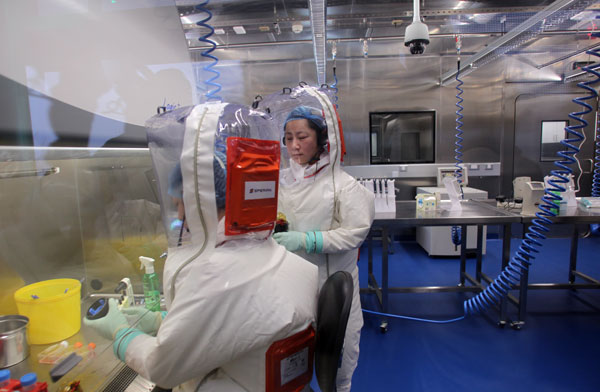Lab joins fight against invisible killers
 0 Comment(s)
0 Comment(s) Print
Print E-mail China Daily, February 6, 2015
E-mail China Daily, February 6, 2015
It kills. It can affect humans and animals. It is incredibly small and can be seen only with extremely strong microscopes. It is a virus.
 |
|
Scientists wearing protective clothing work in the experiment zone at China's first P4 laboratory in Wuhan, Hubei province, on Saturday. Anyone entering the facility has to have undertaken rigorous training to ensure safety and security. Zou Hong / China Daily |
Experts say the only way to fight such invisible threats is to understand them better, and that is why the country has built its first biosafety level-4, or P4, laboratory.
The facility at Wuhan, the capital of Hubei province, was inaugurated on Saturday.
The BSL-4 designation applies to laboratories that take the highest level of biosafety precautions to enable researchers to work with the most dangerous viruses, such as Marburg, Variola and, of course, Ebola.
The latest figures show that, as of Sunday, 22,495 people have been infected and 8,981 have died in the current Ebola outbreak in West Africa.
"Only with such high standards of protection can we carry out experiments with live fatal viruses, instead of gene or protein fragments of them," said Yuan Zhiming, director of the Wuhan lab.
"Globalization and lifestyle changes pose serious challenges to public health by creating and spreading emerging infectious diseases. Building high-protection-level laboratories is an effective way to help control diseases."
Asia's first P4 lab
Previous media reports said there are 59 P4 laboratories worldwide, though many are not operational.
Yuan estimates there are more than 20 P4 laboratories in service worldwide in countries such as the United States, Britain, Germany, France, Canada, Australia and Switzerland.
However, the existence of some of them has not been officially confirmed by the governments concerned.
"When China's P4 laboratory is formally put into service, it will be the first operating P4 laboratory in Asia, and will definitely contribute to the prevention and control of infectious diseases," Yuan said.
The laboratory will be run on a trial basis for up to 18 months, and will then go into full service provided it receives approval from the central government.
Scientists from home and abroad will be able to use the centers's three cellular level laboratories, two animal laboratories, anatomy room and virus storage room.
Chen Xinwen, director of the Wuhan Institute of Virology, said, "A P4 laboratory is different from other large-scale science facilities, as anyone who enters has to have completed security training."
The institute is the laboratory's parent body and took part in its design and construction with the help of the Jean Merieux Laboratory, a P4 facility in Lyon, France.
At present, only six Chinese scientists have been trained to work in P4 facilities. The scientists from Wuhan traveled to Lyon to learn the necessary security procedures.
"Now we have sent a second group of people for training, including some key employees like maintenance personnel," Chen said.
Hu Zhihong, a leading virologist, is one of the six scientists trained in the first group.
"The unique thing about a P4 laboratory is the high level of security," she said.
Everyone who enters the experiment zone has to wear spacesuit-like protective clothing with its own air supply.
After changing into the suit, the researchers take a disinfectant shower and pass through a vacuum room before entering the lab.
"Entering a P4 lab usually takes 30 minutes longer than the time needed to enter a lower-level P3 lab, and you have to go through the same procedures every time you walk from one room to another inside the experiment zone," Hu said.
"As a result, an experiment that takes no more than half an hour in normal circumstances will take two to three hours in a P4 laboratory."
The air in the experiment zone is kept at a much lower pressure than the atmosphere outside the building, and this partial vacuum helps to prevent contamination.
Yuan said: "Vacuums, waste treatment and rigorous security procedures are at the heart of a P4 laboratory.
"Vacuums ensure that the viruses do not escape through the air; waste treatment prevents them from spreading through waste water or other experimental material; and the procedures protect researchers from infection.
"Everything that enters the experimental zone will not leave there alive - except for the researchers."
Creating such tight containment is easier said than done. It has taken 11 years to build the Wuhan facility since the project was given the green light by the government.
China decided to build a P4 laboratory in 2003, when the outbreak of severe acute respiratory syndrome spread alarm across the country.
There were 8,096 cases and 774 deaths in a number countries, with the majority occurring in Hong Kong between Nov 2002 and July 2003.
Top priority
In April 2003, France's then-prime minister Jean-Pierre Raffarin visited China, and the two countries agreed to cooperate over infectious disease control. The construction of the P4 laboratory was regarded as a top priority.
"The cooperation with our French partners assured the completion of the P4 facility, improved our capacity to design, construct and operate the laboratory, and helped our personnel training," Yuan said.
The short-term goal of the laboratory is to carry out research on two or three viruses that pose the most immediate threat to China, including Ebola.
In the long run, it aims to become the World Health Organization's fifth reference laboratory - such labs are able to identify unknown emerging infectious diseases.
"There are no national boundaries for disease control," Yuan said. "We expect to extend our cooperation to all other P4 laboratories to make our laboratory a significant platform for virus research worldwide."






Go to Forum >>0 Comment(s)